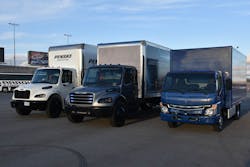DTNA: 'Co-creation' critical to electric truck development
LAS VEGAS. Just weeks after delivering its first electric truck to a customer, Daimler Trucks North America provided a select group of journalists the opportunity to test drive the full range of e-vehicles in its Freightliner Electric Innovation Fleet. Company representatives also used the event, which coincided with the Consumer Electronics Show here, to explain the critical importance of customer involvement as battery-powered trucks move quickly from concept to full production.
While the Class 8 eCascadia has garnered more attention—because highway trucks are the “bread and butter” for Freightliner, in addition to offering a ready response to the hype surrounding the Tesla Semi reveal more than a year ago—medium-duty vehicles will be a “more fruitful” area for electric powertrains in the immediate future, explained Andreas Juretzka, e-Mobility Group Lead for DTNA.
Indeed, as announced last summer, DTNA is building an Innovation Fleet of electric vehicles for fleet test customers, with the first being the eM2 delivered to Penske Truck Leasing in late December. And the announcement that electric trucks were being delivered to Penske and NFI resulted in calls from other customers who also want in, Juretzka added.
But the rollout is limited, he noted, to better control the real-world testing. However, a number of other customers are nonetheless involved in the process.
In addition to working very closely with development teams in Europe and Japan, Daimler has established an Electric Vehicle Council of customers with applications that fit with e-trucks. The process, “co-creation”, entails detailed discussion regarding the next steps in electric vehicle deployment.
“When we started to think about what it takes to get a truck to a customer, we were sure that it’s not only the hardware,” Juretzka said. “We want to be fast, but in e-mobility it’s not only the truck itself or the OEM; it’s about the customer and the utilities and the infrastructure. It’s not enough to give a customer the truck and leave him alone.”
For DTNA, the EV Council—currently about 30 customers—provides a way to explain:
- the products, or the technical details
- costs, including funding options and investment incentives
- maintenance and safety issues, because “it’s going to be different” from what customers are used to; and
- the charging infrastructure and site readiness, including the need to understand a customer’s power demands—and working with utility providers who currently are largely unprepared to meet these new demands.
“Nobody has a clue right now what TCO (total cost of ownership for electric trucks) looks like,” he said. "What kind of application might work, or might not? There's a lot of ideas, but we don't know what the market is really looking for and is hungry for. That's why the council is so important."
Unlike passenger car customers who might buy an electric vehicle for environmental benefits or as a status symbol or even just for fun, for commercial vehicle customers cost is the deciding factor.
So from the other side, customers on the council are educating DNTA on what they expect. After cost, customers are interested in the environmental benefits of electric trucks—but how much of a premium are they willing and able to support? And what exactly do customers need in terms of performance? What about reliability? And what is the best way to address the charging infrastructure, both for initial needs and for the future? And speaking of the future, what will the useful life of an electric truck be? What kind of residual value will electric trucks have?
As Juretzka explained, customers are surprisingly unaware of their actual performance requirements, specifically the daily travel range—because, with conventionally fueled trucks, they haven’t really had to think about it. So when considering electric trucks, they are inclined to ask for more range than they need—but that just-in-case capability reduces payload unnecessarily.
“Everybody said they needed 150-200 kilometers, but actually they’re not going more than 40,” Juretzka said.
Additionally, when the benefits of electric trucks are apparent, some customers might need to reconsider service areas and terminal locations, and redesign routes.
To help its customers better understand whether or not electric trucks will work for them, DTNA is providing eConsulting services to walk them though these issues and come up with an objective application analysis and plan.
The OEM is also working with industry partners such as body builders to explore new designs and materials better suited to electric vehicles, explained Drew Pearson, the eM2 Innovation Fleet Lead.
“We’re looking at the way bodies are constructed right now. The priority has been durability with not much concern for weight,” he said. “Now there are just big opportunities to improve payload capacity and efficiency by stripping some of the weight out of these standard boxes.”
Pearson spoke with Trailer-Body BUILDERS as an editor drove Penske’s Freightliner eM2 around a closed course at the Las Vegas Motor Speedway. The recording of the conversation is noteworthy for its sound clarity: There is no engine noise, and the cab is nearly silent.
More to come.
About the Author
Kevin Jones
Editor
Kevin has served as editor-in-chief of Trailer/Body Builders magazine since 2017—just the third editor in the magazine’s 60 years. He is also editorial director for Endeavor Business Media’s Commercial Vehicle group, which includes FleetOwner, Bulk Transporter, Refrigerated Transporter, American Trucker, and Fleet Maintenance magazines and websites.
Working from Beaufort, S.C., Kevin has covered trucking and manufacturing for nearly 20 years. His writing and commentary about the trucking industry and, previously, business and government, has been recognized with numerous state, regional, and national journalism awards.

